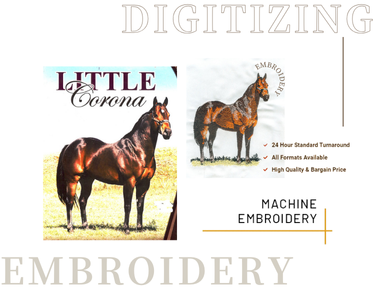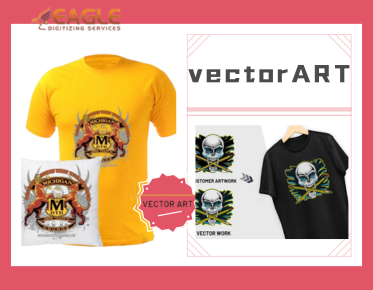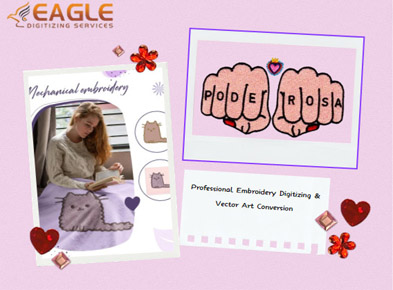The Future of Fashion: Embracing Digital Embroidery
Fashion is always evolving, and one of the most exciting developments in recent years is the rise of digital embroidery. Combining traditional craftsmanship with cutting-edge technology, digital embroidery is transforming the way designers create and produce garments. Let's dive into this fascinating blend of art and tech and see how it's reshaping the fashion world. If this post spurred your interest and you want to find out more about Embroidery Digitizing, please feel free to contact us.
Understanding
Digital Embroidery Fashion
Digital embroidery takes the age-old practice of stitching decorative designs onto fabric and gives it a modern twist. Instead of hand-stitching each element, designers use computerized machines to create intricate patterns with incredible precision and speed. This not only enhances the quality of the embroidery but also opens up endless possibilities for creativity and customization.
The
Evolution of Embroidery in Fashion
Embroidery has a rich history in fashion, dating back centuries. It has adorned royal garments, religious vestments, and everyday clothing across cultures. Traditionally, embroidery was a labor-intensive process, requiring skilled artisans to hand-stitch each piece. However, with the advent of digital technology, the craft has undergone a significant transformation.
From
Handcrafted to Digital: A Brief History
The transition from handcrafted to digital embroidery began in the late 20th century. Early embroidery machines mimicked hand-stitching but were limited in complexity. As computer technology advanced, so did the capabilities of embroidery machines. Today, digital embroidery can replicate the finest details and create complex designs that were once impossible by hand.
What
Makes Digital Embroidery Different?
Digital embroidery differs from traditional methods in several key
ways. Firstly, it allows for precise and consistent stitching, eliminating the
variations that come with handwork. Secondly, it significantly reduces
production time, making it ideal for both large-scale manufacturing and bespoke
creations. Lastly, digital embroidery offers a broader range of design
possibilities, from photorealistic images to intricate patterns.
The Technology Behind Digital
Embroidery
At the heart of digital embroidery is sophisticated technology. Modern
embroidery machines are equipped with computer software that controls the
stitching process. Designers use this software to digitize their artwork,
converting it into a format that the machine can read. The machine then follows
these instructions, stitching the design onto the fabric with pinpoint
accuracy.
Innovative Techniques in Digital
Embroidery
Digital embroidery isn't just about mimicking traditional stitches. It
introduces innovative techniques that push the boundaries of what embroidery
can do. For example, 3D puff embroidery adds texture and depth to designs,
while appliqué techniques combine different fabrics for a layered effect.
Metallic threads and special effects threads can create stunning visual
impacts.
Digital Embroidery Machines: How
They Work
Digital embroidery machines work by reading a digitized design file and stitching it onto the fabric. The process begins with the designer creating a digital version of the artwork using specialized software. This file is then transferred to the embroidery machine, which uses a series of needles and threads to reproduce the design on the chosen fabric. The machine moves the fabric in precise directions, ensuring each stitch is perfectly placed.
Popular
Software for Digital Embroidery Designs
Several software programs are popular among digital embroidery enthusiasts. These include Wilcom, Brother PE-Design,and Hatch Embroidery Software. Each program offers a range of features for designing, editing, and digitizing embroidery patterns. These tools allow designers to experiment with different stitches, colors, and textures, bringing their creative visions to life.
Designing
for Digital Embroidery: Tips and Tricks
Designing for digital embroidery requires a different approach than
traditional methods. Here are some tips to get started:
●
Simplify Your Design: While digital embroidery
can handle complex patterns, it's best to start simple, especially if you're
new to the process.
●
Consider Fabric Type: The type of fabric you use
will affect how the design looks and feels. Test your designs on different
materials to see which works best.
●
Use High-Quality Threads: Investing in
high-quality threads ensures your designs are durable and vibrant.
● Experiment with Stitches: Different stitches can create various effects. Experiment to see which ones best suit your design.
Sustainable
Fashion and Digital Embroidery
Sustainability is a growing concern in the fashion industry, and
digital embroidery offers several eco-friendly advantages. By reducing waste
and allowing for more efficient use of materials, digital embroidery supports
sustainable practices. Designers can produce only what they need, minimizing
excess inventory and reducing the environmental impact.
Reducing Waste with Precision
Embroidery
Precision is one of the biggest benefits of digital embroidery.
Traditional embroidery often results in fabric and thread waste due to human
error. Digital embroidery, on the other hand, ensures the exact placement of
each stitch, significantly reducing waste. This precision not only saves
materials but also ensures higher quality and consistency in the final product.
Eco-Friendly Materials in
Digital Embroidery
Using eco-friendly materials in digital embroidery is another way to support sustainable fashion. Many companies now offer organic cotton threads, recycled polyester threads, and other sustainable options. By choosing these materials, designers can create beautiful, high-quality products that are also kind to the planet.
The
Rise of Customization in Fashion
One of the most exciting aspects of digital embroidery is its ability
to offer customization. Consumers increasingly demand personalized products,
and digital embroidery makes this possible. From custom monograms to bespoke
designs, digital embroidery allows for unique, one-of-a-kind pieces that cater
to individual tastes.
Personalized Fashion: The
Digital Embroidery Advantage
Personalized fashion has become a significant trend, and digital
embroidery plays a crucial role. Whether it's adding initials to a shirt or
creating a custom logo on a jacket, digital embroidery makes it easy to
personalize garments. This level of customization was once reserved for
high-end fashion but is now accessible to a broader audience.
Bespoke Designs Made Easy with
Digital Embroidery
Creating bespoke designs is easier than ever with digital embroidery. Designers can quickly digitize custom artwork and produce it with minimal effort. This process allows for greater experimentation and creativity, enabling designers to offer truly unique pieces that stand out in the market.
Fashion
Trends Influenced by Digital Embroidery
Digital embroidery is influencing various fashion trends, from high
fashion to streetwear. Its versatility and precision allow designers to
incorporate embroidery into a wide range of styles. As technology continues to
advance, digital embroidery will likely play an even more significant role in
shaping future fashion trends.
High Fashion Meets Digital
Embroidery: Designer Collaborations
High fashion designers are increasingly collaborating with digital
embroidery experts to create stunning collections. These collaborations blend
traditional craftsmanship with modern technology, resulting in pieces that are
both innovative and luxurious. Digital embroidery adds a unique dimension to
high fashion, making it an essential tool for contemporary designers.
Streetwear and Digital
Embroidery: A Perfect Match
Streetwear, with its emphasis on individuality and bold designs, is a
perfect match for digital embroidery. Brands can create eye-catching graphics
and intricate patterns that set their products apart. Digital embroidery adds a
premium touch to streetwear, enhancing its appeal to fashion-forward consumers.
Digital Embroidery in Activewear
and Athleisure
Activewear and athleisure brands are also embracing digital
embroidery. This technique allows for the addition of stylish and functional
details, such as logos and patterns that enhance the garment's performance and
aesthetic. Digital embroidery can withstand the rigors of physical activity,
making it ideal for sports and fitness apparel.
Accessories Get a Makeover with
Digital Embroidery
Accessories like bags, hats, and shoes are getting a makeover with digital embroidery. These items, often overlooked in terms of customization, can now feature personalized designs and intricate patterns. Digital embroidery adds a touch of luxury and uniqueness to everyday accessories.
The
Cost-Effectiveness of Digital Embroidery
Digital embroidery is not only innovative but also cost-effective.
Once a design is digitized, it can be reproduced multiple times with minimal
additional cost. This efficiency makes it an attractive option for both
large-scale manufacturers and small businesses looking to offer custom
products.
Mass Production vs. Small Batch:
Finding the Balance
Finding the balance between mass production and small-batch production is crucial in the fashion industry. Digital embroidery allows for both, enabling brands to produce large quantities of a single design or small batches of custom pieces. This flexibility helps designers meet market demands while maintaining quality and uniqueness.
Starting
Your Own Digital Embroidery Fashion Line
Starting a digital embroidery fashion line can be a rewarding venture.
With the right tools and knowledge, you can create unique, high-quality
products that stand out in the market. Begin by investing in a good embroidery
machine, learning the basics of digitizing, and experimenting with different
designs and materials.
Essential Tools and Equipment
for Beginners
For beginners, essential tools include a reliable embroidery machine, digitizing software, high-quality threads, and various types of fabric. Start with simple projects to build your skills and gradually move on to more complex designs as you gain confidence and experience.
Marketing
Your Digital Embroidery Fashion Brand
Marketing your digital embroidery fashion brand effectively is key to
success. Highlight the unique aspects of your products, such as customization
and quality. Use social media platforms to showcase your designs, engage with
potential customers, and build a loyal following. Collaborating with
influencers and participating in fashion events can also help increase
visibility.
Social Media Strategies for
Digital Embroidery Fashion
Social media is a powerful tool for promoting digital embroidery fashion. Share high-quality images and videos of your work, offer behind-the-scenes looks at your creative process, and engage with your audience through comments and messages. Utilize platforms like Instagram, Pinterest, and TikTok to reach a broader audience and attract new customers.
Challenges
and Opportunities in the Digital Embroidery Market
While digital embroidery offers many opportunities, it also comes with challenges. Staying up-to-date with the latest technology and software can be demanding, and the initial investment in equipment can be high. However, the potential for creativity, customization, and efficiency makes it a worthwhile endeavor for those passionate about fashion.
Future
Trends in Digital Embroidery Fashion
The future of digital embroidery in fashion looks bright. Emerging
trends include the use of smart textiles, interactive designs, and sustainable materials.
As technology continues to evolve, digital embroidery will likely become even
more sophisticated, offering new possibilities for designers and consumers
alike.
Innovations on the Horizon for
Digital Embroidery
Innovations in digital embroidery are constantly on the horizon. From advanced digitizing software to machines that can handle more complex designs, the field is rapidly evolving. These advancements will make digital embroidery more accessible and versatile, further cementing its place in the fashion industry.
The
Future is Bright for Digital Embroidery Fashion
Digital embroidery is revolutionizing the fashion industry, blending
traditional craftsmanship with modern technology. Its ability to create
intricate, personalized designs quickly and
efficiently makes it a valuable tool for designers. As technology advances, the
possibilities for digital embroidery will only expand, making it an exciting
area to watch in the world of fashion.



